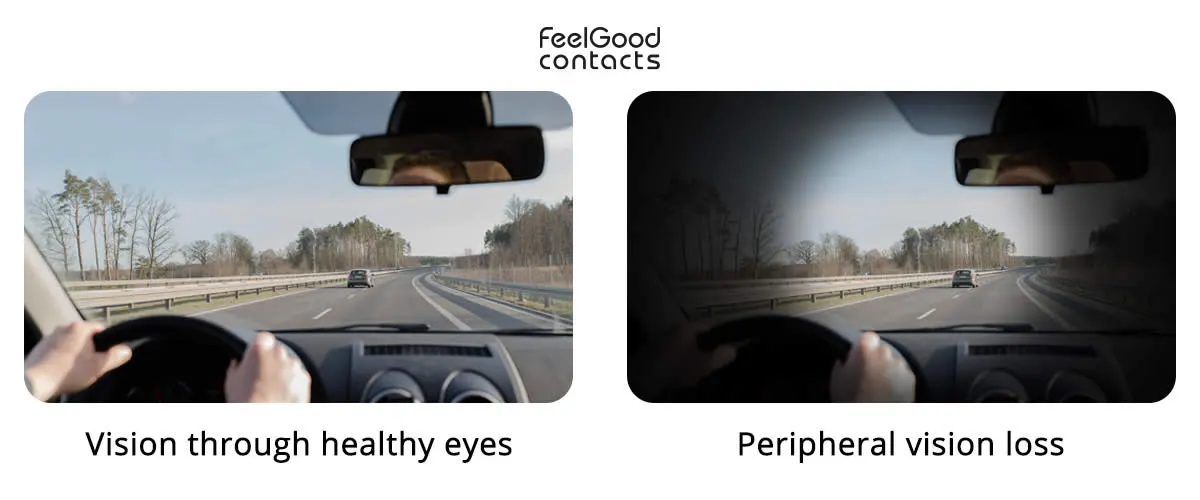Your peripheral vision refers to your side vision. If you lose this, you will struggle or no longer be able to see objects that aren’t directly in front of you.
Your peripheral vision allows you to see objects outside your central field of vision without moving your eyes or turning your head, so without it, day-to-day activities such as driving or playing sports may be particularly challenging.
What is peripheral vision loss?
Peripheral vision loss is when you lose vision beyond your central point of view – this is also commonly known as tunnel vision. Even if your central vision is normal, you won’t have a healthy, wide-angle field of vision without your peripheral vision.

As shown, peripheral vision loss looks as though you are seeing through a narrow tube, everything in front of you is visible, but anything below, above or around appears black (hence the name tunnel vision).
What conditions cause loss of peripheral vision?
Tunnel vision is usually a result of an eye condition such as:
It can also be brought on by health issues such as high blood pressure, carotid artery disease (when fatty deposits clog the blood vessels) or a stroke.
This condition can affect any age group. Depending on the cause, tunnel vision can be temporary or permanent. Nonetheless, if you suspect your wider vision is becoming darker, –consult an eye professional immediately.
How can you tell if you are losing your peripheral vision?
The main symptom of peripheral vision loss is the sides of your vision becoming dark/blurred. However, this is sometimes accompanied by other symptoms, such as:
- Seeing halos or a glare
- Increased or decreased sensitivity to light
- Redness or swelling
- Difficulty seeing in low-lit conditions
- Having trouble whilst driving, such as the inability to see around to spot potential dangers
- Bumping into objects or falling over
These symptoms, however, do not automatically mean you will lose your peripheral vision and may well be a sign of another eye or health condition, which is why it’s vital to be vigilant about your eye health and consult your optician in case of any concerns. An eye professional will be able to perform a visual field test to check for any blind spots within the retina.
Please note that if you drive, you may need to consult an eye care professional or low-vision specialist to see whether you meet the legal requirements to operate a vehicle.
Can tunnel vision be corrected?
Correcting tunnel vision depends on what caused this issue in the first place. For example, tunnel vision caused by glaucoma cannot be restored, but you may be able to manage the situation or prevent it from getting worse by keeping up with your regular glaucoma treatment.
On the other hand, temporary tunnel vision caused by ocular migraines will usually return to normal without treatment.
There is no specific treatment for tunnel vision. You’ll need to treat the cause of it – for example, if you have lost your peripheral vision due to retinal detachment, your eye doctor may recommend surgery to reattach your retina to the back of the eye. Over time, this may restore your peripheral vision.
Please note that tunnel vision cannot be corrected with contact lenses or glasses, however, in some cases, your optician may suggest adding a prism lens to your glasses to expand your field of vision.
Can you prevent loss of peripheral vision?
You cannot directly prevent all peripheral vision loss, however, maintaining good eye health could potentially delay the progression of tunnel vision. We have listed some easy-to-follow pointers for you:
- Wear sunglasses when outdoors in the sun
- Ensure you are having regular eye tests and check ups
- Incorporate vitamins and nutrients that support eye health into diet
An underrated yet crucial part of eye health is understanding your family’s eye health history. Some eye conditions that lead to peripheral vision loss (such as retinitis pigmentosa) are inherited. Making your optician aware of any eye conditions in the family may help them spot anything alarming at an early stage.
Quick links:
A guide to light sensitivity
A guide to blurry vision
A guide to red eyes
Disclaimer: The advice in this article is for informational purposes only and does not replace medical care or an in-person check-up. Please check with an eyecare professional before purchasing any products or remedies. For information on our article review process, please refer to our Editorial Policy.

 Offers
Offers Account
Account
 Favorite
Favorite
 Basket
Basket

 OFFERS
OFFERS
















